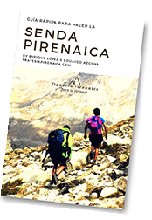What is the FKT on the GR11?

- The FKT (Fastest Known Time) on the GR11, or Senda Pirenaica, is the fastest recorded time to complete this route that crosses the Pyrenees from the Cantabrian Sea to the Mediterranean Sea.
- The FKTs can be attempted in three styles: unsupported, self-supported and supported. The route covers approximately 850 km and has a significant cumulative elevation gain.
The last few weeks we have been following the Geert van Nispen's attempt at the best time on the GR-11, i.e. the FKT (Fastest Known Time).
Beforehand, we talked about how the route was, He was going to attempt the FKT at the beginning of the season and, due to the accumulation of snow we have had this year, the cols were impracticable for a challenge of this type, in which speed is a priority. It's a pity he had to give up. A second attempt is booked for August, which we will follow with great interest.
In connection with the challenge Geert is facing, we have prepared this article. Here are specific details about the challenges, the notable attempts of FKT on the GR11:
What is an FKT?
An FKT is the fastest known time to complete a specific route continuously, without stopping the clock from start to finish. FKTs can be recorded in three different styles:
- Unsupported (Unsupported):
- The athlete carries everything he/she needs from start to finish, except for water which can be collected from natural sources. No external support of any kind is allowed, not even leaving provisions in advance.
- Self-Supported (Self-supported):
- Use of publicly available resources, such as tents and shelters, is permitted, but assistance cannot be received from individuals specifically for the athlete. It is possible to leave hidden supplies before the attempt.
- Supported (With Support):
- The athlete can receive any kind of support along the route, such as accompaniment from others who provide food, water and other supplies. This style allows less weight to be carried and can be the fastest due to the continuous support.
Examples of FKTs in the GR11
- Mario Hipleh (2021): 16 days, 6 hours and 59 minutes in self-supported style.
- Mike Coppock (2020): 16 days, 9 hours and 4 minutes in self-supported style.
- Geert van Nispen: Attempted the FKT in 2024, but had to abandon due to snow accumulation. He plans to reattempt it later in the season (Here is the article we elaborated from their attempt).
Challenges
- Route: More than 800km and 47,000 metres of elevation gain.
- Climatic conditions: The climate in the Pyrenees can be very variable, with extreme temperatures and frequent storms.
- Land: The GR11 has a diverse terrain, from rocky and mountainous paths to wooded trails.
- Logistics: The planning of supplies and resupply points is crucial, especially in the more remote sections.
Rules and Verification
For an FKT to be recognised, it must be verified with clear evidence, such as GPS logs and photos. Attempts must be documented and submitted to the FKT community for review.
Useful Resources
- Fastest Known Time Website: FKT GR11 provides information on previous attempts, rules and how to register your FKT.
- Forums and Communities: Participate in online forums and groups, such as the Crossing forumwhere other athletes share their experiences and advice on the GR11.

Quick guide
GR 11
with everything you need to know before undertaking the Pyrenean Path
Fastpacking is not about going faster. It's about going lighter.
If you come from classic trekking, this is the next step: learning to move with less weight,
more fluid and enjoying every kilometre more.
Join the channel and start discovering what lightness feels like.
